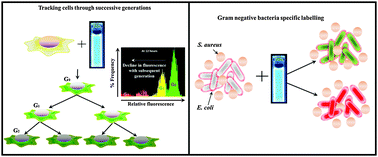Multifunctional carbon dots as efficient fluorescent nanotags for tracking cells through successive generations†
Abstract
Although extensive reports on the synthesis and application of diverse carbon dots (CDs) merely for the sake of live cell imaging already exists, their bid in fluorescence based cell assays still remains limited. Thus, taking the CDs bio-labelling application a step further, in the present work biocompatible multicolour fluorescent CDs have been synthesised from casein, which, in addition to labelling cells, also efficiently tracks them through successive generations. As an implication of this, these CDs, upon internalization by cells, could categorise an entire cell population into multiple generations with a resolution much better than that attained by commercial cell tracking organic dyes. In addition to this, as-prepared CDs also revealed an interesting inherent ability to selectively label E. coli (Gram negative) and exclude S. aureus (Gram positive) in a mixed population which further extends their scope for diagnostic applications. With an outcome of such intriguing applications of these CDs, the present work also outlines the synthesis of CDs followed by comprehensive characterization of fluorescence and physico-chemical properties of the as-prepared CDs. In brief, this study adds a new facet to commercial applications of CDs as an efficient alternative to organic dyes for bio-labelling assays.


 Please wait while we load your content...
Please wait while we load your content...